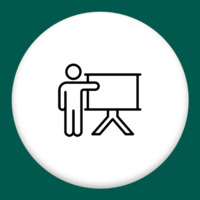Engaging the Public: Virtual Reality, Photogrammetry, and Accessibility
Citation
Gniady, Tassie and David Kloster. "Engaging the Public: Virtual Reality, Photogrammetry, and Accessibility." 11 Apr 2017. HASTAC 2017, Orlando, FL.
Description
Given the intersectional nature of good digital humanities scholarship, it only makes sense that one source of intersection lies outside the university. At Indiana University—Bloomington the Advanced Visualization Lab and the Cyberinfrastructure for Digital Humanities Group are in the same Research Technologies portfolio and often work together, but approaching these two research entities as someone without a connection to IU is difficult.
One of our community partners is the Monroe County Public Libraries. Taking two of our most popular areas of expertise, virtual reality and 3D object creation via photogrammetry, two camps will run side-by-side in June of 2017. As one set of campers create a virtual downtown with any added twists they wish, another set will go on photo safaris to capture outdoor works of art and items from the Monroe County History Center, then learn how to stitch and clean them to make 3D digital objects. Finally, the virtual reality camp will integrate the 3D objects before the public showcase capping off the week.
Both the constituency of these camps and their sources of data are important to us. Many of the campers (ages 12 and up) do not have access to these technologies anywhere besides the public library, and, because the camps are free, there is no financial barrier to entry. Camps held at the public library often draw from a wide cross-section of the Bloomington population, unlike events held on campus—despite the fact that the two entities are only two blocks away from each other. Secondly, by focusing on downtown Bloomington and its environs, campers will be taking spaces they are familiar with and rendering them in new ways that go beyond simple recreation—for example, we plan to encourage the creation of a sculpture park that doesn't exist in the real world and can include photogrammatized objects as well as virtually created ones. Similarly, campers can add interiors to some of the buildings in the downtown square and create any kind of rooms they wish.
It is our hope that by reaching out to the community in this way, by marrying history, reality, and imagination, that some of the work done on campus will carry over and attract community members to continue to experiment on their own at the public library (which owns a collection of HTC Vives and had Unity installed in a lab of computers), to attend public lectures and workshops on campus, and to generally break down some of the barriers that may make some members of our community feel less engaged with the university and/or the new technologies it offers.
I will bring 3D prints resulting from the camp, as well as environments created by our campers (as well as some Google Cardboards).
One of our community partners is the Monroe County Public Libraries. Taking two of our most popular areas of expertise, virtual reality and 3D object creation via photogrammetry, two camps will run side-by-side in June of 2017. As one set of campers create a virtual downtown with any added twists they wish, another set will go on photo safaris to capture outdoor works of art and items from the Monroe County History Center, then learn how to stitch and clean them to make 3D digital objects. Finally, the virtual reality camp will integrate the 3D objects before the public showcase capping off the week.
Both the constituency of these camps and their sources of data are important to us. Many of the campers (ages 12 and up) do not have access to these technologies anywhere besides the public library, and, because the camps are free, there is no financial barrier to entry. Camps held at the public library often draw from a wide cross-section of the Bloomington population, unlike events held on campus—despite the fact that the two entities are only two blocks away from each other. Secondly, by focusing on downtown Bloomington and its environs, campers will be taking spaces they are familiar with and rendering them in new ways that go beyond simple recreation—for example, we plan to encourage the creation of a sculpture park that doesn't exist in the real world and can include photogrammatized objects as well as virtually created ones. Similarly, campers can add interiors to some of the buildings in the downtown square and create any kind of rooms they wish.
It is our hope that by reaching out to the community in this way, by marrying history, reality, and imagination, that some of the work done on campus will carry over and attract community members to continue to experiment on their own at the public library (which owns a collection of HTC Vives and had Unity installed in a lab of computers), to attend public lectures and workshops on campus, and to generally break down some of the barriers that may make some members of our community feel less engaged with the university and/or the new technologies it offers.
I will bring 3D prints resulting from the camp, as well as environments created by our campers (as well as some Google Cardboards).
URL
Date
Apr 2017
Staff
Type
Presentation
